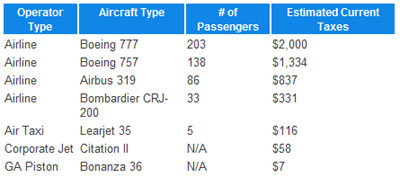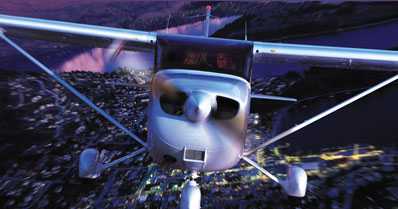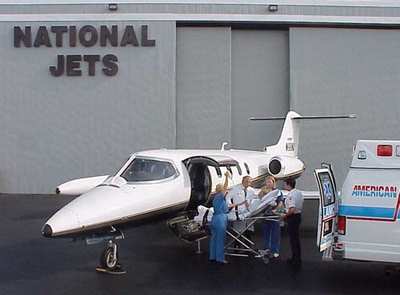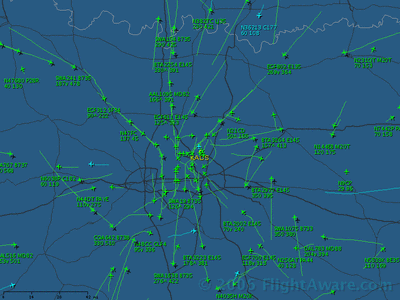 ...When I was here last month
to testify on our fiscal 2008 budget, Secretary Peters had sent our
proposal to Congress that day. Even though during that hearing we
touched on some of the major elements of the bill, I am grateful
for the opportunity to return and discuss our proposal in greater
depth. While our proposal has generated some spirited debate
already, I think we can all agree that we share two fundamental
goals for reauthorization: first, that we continue to keep
our air transportation as safe as we possibly can, and, second,
that we have the ability to grow the system to meet our
nation’s future air transportation needs. The
Administration’s proposal leads us towards these goals by
supporting the transformation of our air transportation system,
responding to a changing aviation industry, and creating a rational
funding system that ties revenues to costs.
...When I was here last month
to testify on our fiscal 2008 budget, Secretary Peters had sent our
proposal to Congress that day. Even though during that hearing we
touched on some of the major elements of the bill, I am grateful
for the opportunity to return and discuss our proposal in greater
depth. While our proposal has generated some spirited debate
already, I think we can all agree that we share two fundamental
goals for reauthorization: first, that we continue to keep
our air transportation as safe as we possibly can, and, second,
that we have the ability to grow the system to meet our
nation’s future air transportation needs. The
Administration’s proposal leads us towards these goals by
supporting the transformation of our air transportation system,
responding to a changing aviation industry, and creating a rational
funding system that ties revenues to costs.
The Administration’s proposal supports the transformation
to the Next Generation Air Transportation System (NextGen). Without
this transformation, the current system is simply incapable of
accommodating future demand. As we look out into the future, we see
a system that will need to grow to accommodate the demands of our
stakeholders and the flying public. These issues will be front and
center at our annual Aviation Forecast Conference, which begins
tomorrow. Passenger demand has returned to pre-9/11 levels and we
project that the system must be ready to serve over 1 billion
passengers annually by 2015, and continuing growth through 2025. It
will be difficult to meet this challenge under the current system,
where the needs of NextGen must compete with other funding
priorities in the appropriations process. The
Administration’s proposal meets this challenge by largely
funding NextGen investments through user-supported offsetting
collections.
The current financing mechanisms, both in terms of taxes and
spending, are not tied to FAA’s cost to deliver services, and
therefore are not scalable to meet these growing demands. This can
be illustrated by example. Consider two identical aircraft, flying
the same route from Boston to Miami, one full of passengers, and
the other only half–full. Although both planes impose the
same air traffic control costs on the system, the full plane will
contribute far more to the funding of the air traffic control
system. As another example, consider an airline that is replacing a
large aircraft flying between two cities, with two smaller aircraft
flying the same number of people between those cities. This change
in service will impose twice as much cost on the air traffic
control system, but under the current system, there is no incentive
for the airline to consider those additional costs in its decision.
Finally, the greatest flaw in the current system becomes apparent
when one considers that while a corporate jet consumes the same air
traffic control services as a commercial airline, because the
corporate jet has no passengers, under the current financing
system, it contributes far less to the funding of air traffic
control services than ticketed passengers flying on the commercial
airline. The following table highlights this issue for a number of
illustrative flights from the Los Angeles area to the San Francisco
area:

Under the current tax structure, it is clear that taxes paid by
different user categories do not generally reflect the costs those
users impose on the system. Commercial airline passengers currently
pay over 95 percent of the Trust Fund taxes, but our cost
allocation shows that the aircraft carrying them account for
approximately 73 percent of air traffic costs. In many cases, "high
end" turbine (jet and turboprop) general aviation (GA) flights are
consuming similar FAA and airspace resources as the commercial
operators, but paying only a fraction of what commercial operators
pay through the passenger taxes. For example, as the table above
shows, a corporate jet flying from Los Angeles to San Francisco
today pays only 17% of what a 50-seat regional jet pays, and less
than 5% of what a Boeing 757 pays. In other words, commercial
operators and everyday passengers are subsidizing use of the system
by corporate jets. I do not believe this is equitable.
Because of the fundamental disconnect between the existing tax
structure and the FAA’s workload, we strongly believe that
the FAA needs to move to a different, more rational funding
mechanism. The Administration’s proposal creates a
transparent financing system where aviation users pay for FAA
services through user fees and fuel taxes, so that all users pay
their fair share of air traffic control services. Most commercial
aviation operators would pay for their fair share of the costs of
air traffic control services through user fees, while general
aviation users and some commercial users would pay for these
services through a cost-calibrated fuel tax. This linkage between
what users pay and what FAA invests in will be critical to
facilitate our transition to the NextGen modernization of the air
traffic control system.
I want to be clear that the primary purpose of this proposal is
not about collecting more money for the FAA, it is about creating a
more rational, equitable, and stable system that provides
appropriate incentives to airspace users to efficiently use
increasingly congested airspace, to the FAA to control costs.
However, by adopting new discretionary user fees and authorizing
borrowing, the Administration’s proposal does allow the FAA
the flexibility to meet the financing challenges of NextGen and
facilitates modernization of the aviation system on an assured and
predictable basis.

The new system will facilitate more reliable, more predictable,
and less congested air travel for the traveling public. The FAA
will continue to have strong congressional and public oversight,
and our proposal adds additional oversight through a newly created
Air Transportation System Advisory Board to play a role in key
agency financial decisions and provide strong incentives for the
FAA to control costs and meet the demand for services efficiently.
The financing proposal is the product of both significant
consultation with the public, including our aviation stakeholders,
as well as a detailed analysis of the current financing system and
various alternatives. We have attempted to balance the diverse
views that our stakeholders have expressed with the need for a
stable, equitable, and cost-based funding structure. Our
recommended solution builds on the work of numerous bi-partisan
commissions from the past two decades, including the National Civil
Aviation Review Commission that Congress created and that former
Secretary Mineta chaired approximately ten years ago.
Let me describe in greater detail how our proposal would fund
the different parts of the FAA.
Proposed Funding for the Air Traffic Organization (ATO)
The cost of ATO’s services will primarily be funded by
those operating in the system. The manner of contribution will vary
depending on the type of operation. Turbine commercial flights
would primarily pay user fees; general aviation and all
piston-powered flights would primarily pay fuel taxes; and the
General Fund would finance the costs of services provided to public
users and other programs that are in the general public
interest.
 User fees would apply to turbine
commercial flights, including those by US and foreign airlines,
passenger and freight carriers, domestic and international flights,
charter operators, and regional airlines. They would cover all
flights by jet aircraft that are considered commercial under the
current tax code, including air taxis and flights operated under
fractional ownership. Collecting user fees for air traffic services
is an internationally accepted practice in widespread use around
the world, and would be consistent with the recommendations of at
least seven bi-partisan commissions that have studied this issue
over the last two decades. These fees would be based on data
derived from the agency’s cost accounting and cost allocation
systems — including the operations, maintenance, and overhead
expenses for the services provided, the facilities and equipment
used in such services, and the projected costs for the period
during which the services are provided. Existing US overflight fees
would be integrated into these new user fees. While the proposal
gives the FAA and its users latitude in how the fees would be
structured, these fees would clearly tie FAA revenues much more
closely to the actual cost of the services provided. We anticipate
that approximately three-fourths of the Air Traffic
Organization’s budget would come from these user fees.
User fees would apply to turbine
commercial flights, including those by US and foreign airlines,
passenger and freight carriers, domestic and international flights,
charter operators, and regional airlines. They would cover all
flights by jet aircraft that are considered commercial under the
current tax code, including air taxis and flights operated under
fractional ownership. Collecting user fees for air traffic services
is an internationally accepted practice in widespread use around
the world, and would be consistent with the recommendations of at
least seven bi-partisan commissions that have studied this issue
over the last two decades. These fees would be based on data
derived from the agency’s cost accounting and cost allocation
systems — including the operations, maintenance, and overhead
expenses for the services provided, the facilities and equipment
used in such services, and the projected costs for the period
during which the services are provided. Existing US overflight fees
would be integrated into these new user fees. While the proposal
gives the FAA and its users latitude in how the fees would be
structured, these fees would clearly tie FAA revenues much more
closely to the actual cost of the services provided. We anticipate
that approximately three-fourths of the Air Traffic
Organization’s budget would come from these user fees.
The fees would be dedicated to air traffic control and related
services and would be subject to oversight through the annual
budget and appropriations process and treated as discretionary
offsetting collections for budget purposes. Congressional
appropriators would receive credit for these collections and would
make them available for expenditure through annual appropriations
action. The user fee spending would be fully offset by the user fee
collections. It would rise or fall based on FAA’s costs and
would not compete with any other discretionary budget priorities
(as spending Trust Fund revenues do today).
The general aviation (GA) community and piston commercial
operations would contribute their allocated share of air traffic
control costs primarily via a fuel tax. We have considered
stakeholder feedback from this community and accept the argument
that the efficiency and simplicity of the fuel tax mechanism merit
its continued use as the primary mechanism for GA's contribution to
FAA funding. We identified the costs associated with these users
and then set the fuel tax rates to recover those costs. We
anticipate that just over 10 percent of the ATO's budget would come
from these taxes, which would continue to be deposited in the Trust
Fund and be subject to appropriation. The bill proposes
periodically recalibrating the portion of the GA fuel tax dedicated
to funding ATO based on updates to FAA's cost allocation study.
In addition to the fuel tax, GA and piston commercial flights
may be subject to a terminal user fee when they arrive or depart at
one of a limited number of large hub airports. In general, these
airports are the most congested terminal facilities in the aviation
system, and all users at congested facilities contribute to
congestion for other users. Given that large hub airports are in
metropolitan areas that have alternative airports, which would not
be subject to this fee, we believe it is appropriate to apply fees
to all users of the most congested airports.
The costs associated with air traffic control service for
military and other public users, as well as other functions and
services deemed to be in the general public interest would be
funded from the General Fund appropriation, as discussed below.

Proposed Funding for Aviation Safety
The funding proposal includes modest user fees to pay for the
costs of 25 activities in the areas of certification and
registration. These include issuance of certain certificates,
appointment and training of designees, registration of aircraft and
airmen, airmen medical certificates, and training provided to other
aviation authorities. All of these activities are specific services
that FAA provides for individual businesses; other federal, state
and local government agencies charge for similar services, as do
many international aviation authorities. They are FAA products and
services that have value to those who receive them, and that are
initiated by customer action. In fact, FAA currently charges fees
for many of these services; however, the current fees are set
significantly below the cost of providing the service — and
below the price of other comparable services. For example, the $5
it currently costs to register an airplane would not go very far
toward registering a car in most states. The legislation specifies
the amount to be charged for 12 specific services. Thirteen other
activities are identified for which fees will be collected, but do
not have the unit charge specified as FAA's cost accounting system
is still being implemented with respect to regulation and
certification activities. As with the ATO fees, the charges for
these activities will be determined based on the available data
derived from the agency's cost accounting and cost allocation
systems and revenue from the fees would be treated as offsetting
collections. Based on the historical cost of these activities, DOT
anticipates that approximately 10 percent of FAA's Aviation Safety
budget will come from user fees.
Regardless of the type of product or amount of fee determined
for that product, FAA will always make fee decisions considering
safety first. We are also mindful of the significant international
leadership role of both the FAA and the US industry, and the fact
that benefits from many aviation safety functions (such as ongoing
surveillance) are widely dispersed to the traveling and
non-traveling public. No fee structure will compromise the FAA's
statutory safety responsibilities or the US aviation community's
ability to remain the world's principal system innovator. As a
result, we are proposing that the vast majority of FAA's aviation
safety responsibilities remain funded from the General Fund.
General Fund Proposal
The Administration derived its General Fund proposal by
evaluating specific activities to determine whether they are in the
general public interest and have a compelling case for a General
Fund appropriation. The dollar figures in the reauthorization
proposal are based on the following activities and services:
- Air traffic costs allocated to public users (military, other
government aircraft, and air ambulances), because providing air
traffic control services to these flights as serving the public
good;

- Flight service stations, because charging user fees for these
services would encourage general aviation pilots to fly "outside
the system," which would have a negative safety impact;
- Low activity towers, because they help provide safe access to
the aviation system to numerous small communities and are a
critical part of the national aviation infrastructure; the primary
users of these terminals (piston aircraft) likely cannot bear the
cost of funding them, even though many of these towers are contract
towers, which are the FAA's most cost-efficient facilities;
- Safety regulation and oversight that are not recovered by user
fees, because these regulatory functions benefit the general public
by contributing to a safe and reliable air transportation
system;
- Commercial Space Transportation, because, given the early and
volatile state of the industry, it would be virtually impossible to
develop a schedule of fees that would generate significant revenue
without unduly burdening the industry and placing US companies at a
competitive disadvantage compared to heavily subsidized firms from
other countries; and
- The portion of Research, Engineering and Development
(RE&D), sponsored by FAA's Aviation Safety organization,
related to aging aircraft and aircraft catastrophic failure
prevention (approximately $17 million of the RE&D budget),
because this research supports FAA's "public good" regulatory
functions.
Transition and Elimination of Other Aviation Excise Taxes
 The Administration proposes that the
changes to the aviation financing system take effect at the start
of fiscal year 2009, in order to provide the FAA with sufficient
time to establish user fees and implement a billing and collection
system. Our proposal therefore extends the current excise taxes for
one year to ensure that the FAA has sufficient funding in FY
2008.
The Administration proposes that the
changes to the aviation financing system take effect at the start
of fiscal year 2009, in order to provide the FAA with sufficient
time to establish user fees and implement a billing and collection
system. Our proposal therefore extends the current excise taxes for
one year to ensure that the FAA has sufficient funding in FY
2008.
As of FY 2009, the existing domestic ticket tax (including the
tax on mileage awards), domestic segment tax, cargo waybill tax,
and Alaska/Hawaii departure tax would expire under our proposal.
The proposed user fees, adjusted fuel taxes, and the adjusted
international arrival and departure tax would replace these taxes.
This represents a significant simplification of the aviation excise
tax system.
FAA Governance
A review of air traffic service providers around the world shows
that one of the common changes accompanying the introduction of
user fees is adoption of a "user pays, user says" policy --
according users a significant role in decisions relating to the
setting of fees and the use of moneys collected.
Therefore, our proposal creates an Air Transportation System
Advisory Board, comprised of user representatives and public
interest members appointed by the Secretary, which would have a
significant role in the decisions of the agency. Although the FAA
Administrator and the Secretary retain ultimate responsibility for
the safety and operation of the National Airspace System and thus
have the final decision authority, the Board would provide advice
and recommendations on the creation and adoption of user fees, and
would propose modifications to them on a periodic basis. Under our
proposal, if the Board does not approve the establishment or
modification of a fee, the Administrator can only implement it
after publishing a written determination in the Federal Register.
This Board would also review and make recommendations with respect
to major capital infrastructure decisions and modernization
projects, the agency's strategic plan, and the development and
adoption of ATO's operational performance metrics. Finally, the
Board would review and provide advice on FAA's safety programs,
budget, and cost accounting system. Of course, as the FAA is a
government agency, Congress will always have the ultimate oversight
authority.
The FAA Administrator and a representative from the Department
of Defense would be Board members, along with members representing
airports, air carriers, general aviation, business aviation,
aviation manufacturing, and the public interest. The Management
Advisory Council and Air Traffic Services Committee would be
discontinued with the creation of this new Board.
Proposed Funding for AIP, RE&D and EAS
 The Subcommittee has scheduled a
separate hearing on the airport-related portion of reauthorization
for later this month, at which time we will provide detailed
testimony on those aspects of our proposal. For the moment, we
would briefly note the funding aspects of our proposal. Airports
are a key part of the system, and that includes small primary and
general aviation airports that rely on AIP funding to help meet
their capital needs. We have proposed changes to Federal funding
programs that will stabilize and enhance these funding sources for
airports. Our proposal ensures that smaller airports that cannot
generate sufficient funding on their own can rely on their
entitlement funds to complete strategic projects. These airports
play an important role in the national aviation system.
The Subcommittee has scheduled a
separate hearing on the airport-related portion of reauthorization
for later this month, at which time we will provide detailed
testimony on those aspects of our proposal. For the moment, we
would briefly note the funding aspects of our proposal. Airports
are a key part of the system, and that includes small primary and
general aviation airports that rely on AIP funding to help meet
their capital needs. We have proposed changes to Federal funding
programs that will stabilize and enhance these funding sources for
airports. Our proposal ensures that smaller airports that cannot
generate sufficient funding on their own can rely on their
entitlement funds to complete strategic projects. These airports
play an important role in the national aviation system.
We propose to continue financing the AIP program through taxes.
The proposed taxes are administratively simple and build on
existing collection mechanisms. Specifically, our bill would fund
the AIP program via a set of simplified excise taxes, consisting of
a flat, universal fuel tax for domestic commercial and all GA
flights and an international passenger head tax for international
commercial passenger flights. This universal fuel tax would be in
addition to the proposed GA ATO fuel taxes for GA users and piston
commercial users. Like the ATO taxes, these taxes would be
deposited into the Airport and Airway Trust Fund and be subject to
Congressional appropriation. The proposed taxes are expected to
generate receipts sufficient to cover the proposed authorization
levels for AIP, the Essential Air Service (EAS) program, and the
Trust Fund's portion of RE&D. If the enacted authorization
levels are different from the proposed levels, the tax rates
proposed could be adjusted accordingly. The bill also proposes
indexing both the AIP portion of the fuel tax and the international
passenger tax to keep pace with inflation.
The universal fuel tax and international passenger tax would
also be the funding sources for all of EAS and most of RE&D. As
in the case of AIP, it is appropriate for users to fund most
research and development because it ultimately benefits them, but
it is challenging to allocate research costs to specific users.
Similarly, EAS has a long history of being funded by users through
overflight fees; however, it is not part of air traffic control
costs, and similar to AIP, is largely a grant program to assist
small communities that cannot support service on their own.
Therefore, the Administration has included EAS and RE&D funding
requirements in the proposed universal fuel tax and international
passenger tax rates. However, AIP is the primary driver of the tax
rates.
NextGen – Funding of Major Capital Projects
As I stated at the outset, one of the drivers of our proposed
changes to how the FAA is funded is to the challenge of funding
NextGen. Implementing NextGen will be a unique transition from the
technology of 50 years ago to the technologies of tomorrow and it
will require a substantial investment of capital. Financing this
investment is something I have very strong views about. Business as
usual is not an option. As noted above, the new discretionary user
fees we propose will enable us to fund several important NextGen
investments. However, to avoid spikes in the user fee levels our
proposal would also authorize us to borrow through the Secretary of
the Treasury beginning in FY 2013, with debt service recovered from
users of the system by FY 2017. This authority would contribute to
a more business like funding structure, leverage limited resources,
and further accelerate the transition to NextGen by better aligning
payment for a project with the benefits that project generates and
providing greater flexibility to take advantage of capital
investment opportunities as technology changes.

Examples of FAA projects that may be appropriate for debt
financing include safety-critical and mission-essential software
and systems that controllers and traffic flow managers will use to
support trajectory based operations in the NextGen system,
enhancements to the global positioning system (GPS) technology
related to civil aviation, surveillance technology for homeland
security and defense, and potential facility consolidation. This
authority would be targeted, as noted, for a limited time period
(FY 2013 to FY2017) and would be capped at $5 billion. We think
this innovative authority will give us what we need when we need
it.
Congestion Charges at Certain Capacity-Constrained
Airports
While our bill will provide us the tools to be prepared for the
future, we must also manage our current system safely and
efficiently. To that end, I wish to briefly note two provisions in
our bill that would authorize the use of market-based mechanisms
(e.g., auctions or congestion pricing) to control congestion and
delay at capacity-constrained airports. While FAA's policy is to
expand capacity to meet demand, physical expansion is not feasible
at certain airports, most notably at New York's LaGuardia Airport.
Therefore, specifically with regard to LaGuardia, our bill would
give the Secretary and the FAA statutory authority to authorize the
Port Authority of New York and New Jersey (Port Authority) to use
market-based mechanisms at the airport. The language generally
complements rulemaking FAA is currently undertaking with respect to
LaGuardia to replace the expired High Density Rule (HDR). If the
Port Authority implements a market-based mechanism and such
mechanism produces annual revenue in excess of associated
administrative costs, the Port Authority would have to deposit the
excess revenue in an escrow account. It could then use those funds
on otherwise eligible airport related projects or any other project
that the Secretary finds is in the public interest. If the Port
Authority fails to implement a market-based mechanism at LaGuardia
within one year of the Secretary's determination, the Secretary
would have authority to implement such a mechanism at the
airport.

Similarly, the second provision establishes a pilot program
allowing for broader evaluation of market-based mechanisms. The
Secretary could approve the participation of up to 15 airports in
the program. For airports experiencing congestion that results in
delays affecting the regional airspace, participating airports
could implement a market-based mechanism, for domestic flights, to
the extent necessary to achieve a target reduction in congestion
and operating delays. The amount of the fee would be set by the
airport operator. Any surplus revenue that results would be placed
in an escrow account to be used only for airport related projects
or any other project the Secretary finds is in the public interest
with priority given to projects at the airport where the fees were
collected. The program would also provide for participation of
airports experiencing congestion that results in more widespread
delays.
Environmental Stewardship and Streamlining
Part of our NextGen vision is to provide environmental
protection that allows for sustained growth in our aviation
system.Our proposal includes provisions to enhance the FAA's
ability to work cooperatively with our partners to preserve the
environment by developing technologies, operational procedures, and
best practices to minimize the impact of aviation. Our goal is an
aviation future that is quieter, cleaner, and more energy
efficient. Key environmental stewardship provisions include:
- A research consortium for the development, maturing, and
certification of lower energy, emissions, and noise engine and
airframe technology over the next ten years;
- A permanent Airport Cooperative Research Program for research
and development specifically related to the airport
environment; and
- An environmental mitigation demonstration pilot program to
demonstrate the noise, air quality, or water quality benefits of
promising research concepts at airports.
We have also proposed environmental streamlining provisions that
are intended to improve the administration of current programs
without affecting environmental quality in such areas as the state
block grant program and the air tour management program.
Realignment and Consolidation of Aviation Facilities and
Services
As we plan to transform our air transportation system, we must
also transform ourselves as an agency — a provider of
services to the aviation community. Our bill includes a proposal
that would create a specific process for the comprehensive study
and analysis of how we could realign and consolidate our services
and facilities to help us reduce capital, operating, maintenance,
and administrative costs on an agency-wide basis with no adverse
effect on safety. In addition to our current authority, this
provision would provide a critical tool that the FAA could use to
operate in a more business-like fashion. Any realignments or
consolidations recommended by the Administrator under to this
section would only be implemented after a thorough review by a
newly created Commission of experts, and the opportunity for the
public, and ultimately, Congress, to examine the
recommendations.

Extension of Aviation Insurance Program
Finally, I wish to mention our proposal for the FAA's aviation
insurance program. This is a program that has been very important
in recent years to the continued operations of the industry, but
which, we feel needs some adjustments. Our bill would extend the
Secretary's overall authority to provide aviation insurance, now
set to expire on March 30, 2008, to March 30, 2013. It also removes
current requirements for the program to provide first dollar
coverage, thus permitting deductibles and the opportunity for
commercial coverage of those deductibles. Current law allows the
Secretary to limit an airline's third-party liability to $100
million and also prohibits punitive damages against an airline,
aircraft or engine manufacturer, as well as the Government for any
cause resulting from a terrorist event. This authority to limit
liability is also extended by this section.
Conclusion
Mr. Chairman, I want to conclude by emphasizing that I know we
all share the same basic goals for an industry that we all care
about deeply. We want a safe system that can meet future
demand–one that is cost effective and efficient and that meet
the needs of the flying public. We all appreciate the importance of
this industry, not only to those of us lucky enough to be a part of
it, but to every American. While I anticipate and look forward to a
frank and wide-ranging discussion of this proposal and others that
I am sure will be put on the table, I cannot overstate my personal
commitment to the need for a funding system that better ties FAA's
costs to its revenues and its revenues to its spending. Changing
how we fund and operate our system will be hard, but maintaining
the status quo will not get us what we all want: a more efficient,
modern aviation system.
 Aero-News: Quote of the Day (04.17.24)
Aero-News: Quote of the Day (04.17.24) ANN's Daily Aero-Linx (04.17.24)
ANN's Daily Aero-Linx (04.17.24) Airborne-Flight Training 04.17.24: Feds Need Controllers, Spirit Delay, Redbird
Airborne-Flight Training 04.17.24: Feds Need Controllers, Spirit Delay, Redbird Airborne 04.16.24: RV Update, Affordable Flying Expo, Diamond Lil
Airborne 04.16.24: RV Update, Affordable Flying Expo, Diamond Lil Airborne 04.11.24: SnF24!, King's 50th, Top Rudder, Aileronics
Airborne 04.11.24: SnF24!, King's 50th, Top Rudder, Aileronics














